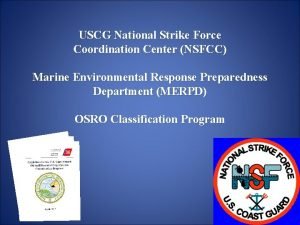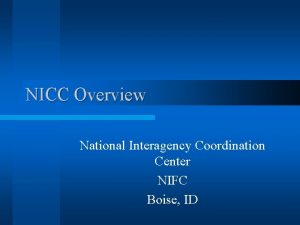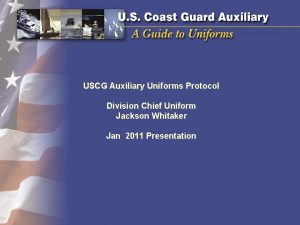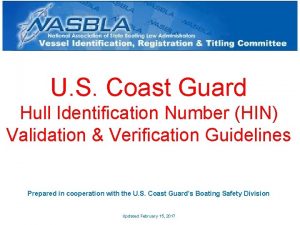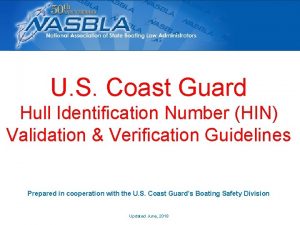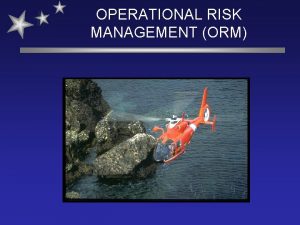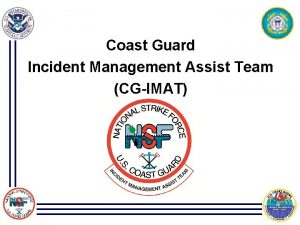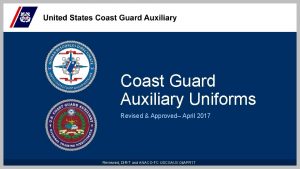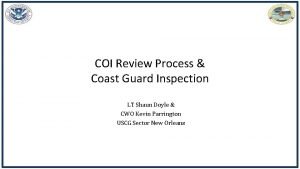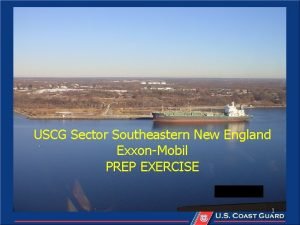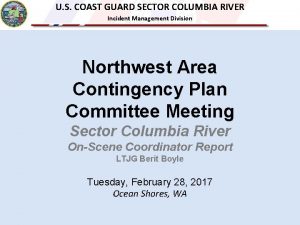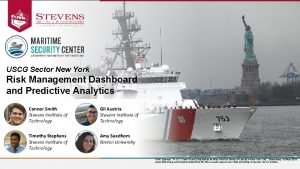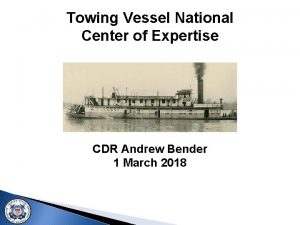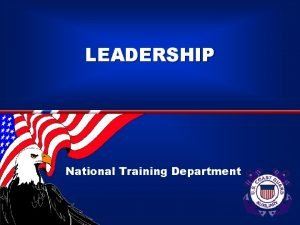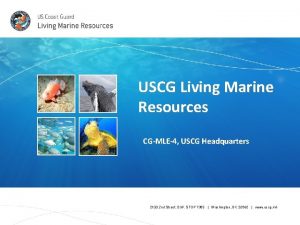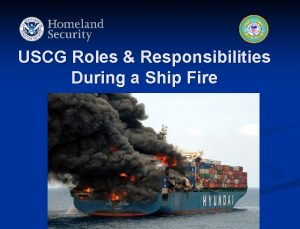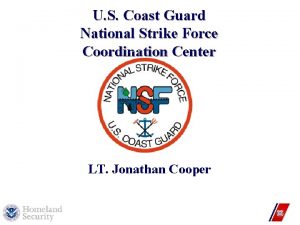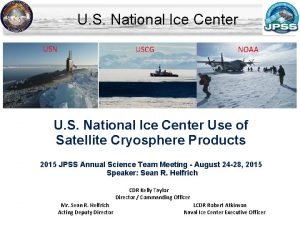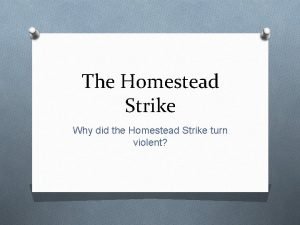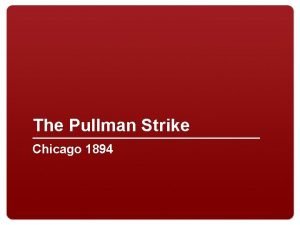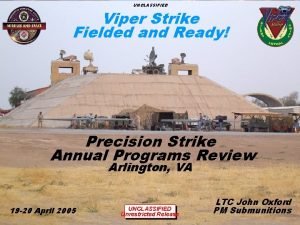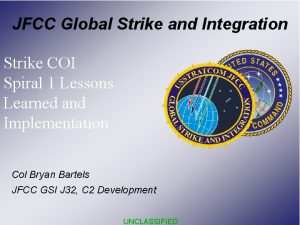USCG National Strike Force Coordination Center NSFCC Marine

















- Slides: 17

USCG National Strike Force Coordination Center (NSFCC) Marine Environmental Response Preparedness Department (MERPD) OSRO Classification Program

Marine Environmental Response Preparedness Department (MER PD) Components • The MER PD consists of 8 permanent personnel and 5 reservists: - LCDR, LT, MST 1, MST 2, MK 2 and 3 Civilians. - LT, 2 MSTCs, MST 2 and MST 3. • Response Support Division Responsibilities include: – Response Resource Inventory (RRI) Database Management • 443+ Total Users, 150 Classified OSROs • 3290 sites within the RRI – Preparedness Assessment Verification (PAV) Program • • Average 12 -14 PAVs annually PAVs typically are 1 -2 weeks in length 4 High Volume COTP Zones Annually Pacific Rim & Alaska Annually

RRI PROGRAM OVERVIEW • Under Section 4202(b)(2) of the Oil Pollution Act of 1990, a National Response Unit (NRU) was charged to compile and maintain a comprehensive computer list of spill removal resources, personnel, and equipment that is available worldwide. • 40 CFR 300 (NCP) defined the National Strike Force Coordination Center as the National Response Unit in Elizabeth City, North Carolina, to maintain response resource inventories. • Response Resource Inventory (RRI) - A publically accessible equipment database implemented in 1992 where an OSRO voluntarily reports its response capabilities.

Response Resource Inventory (RRI) Inception & Implementation Timeline Oil Pollution Act of 1990 (OPA 90) 33 U. S. C. 2701 et seq. Mandated establishment of a National Response Unit originally authorized under the Clean Water Act National Oil and Hazardous Substances Pollution Contingency Plan (NCP) 40 CFR § 300. 145 (Special teams and other assistance available to OSCs/RPMs) 40 CFR § 300. 145 (a)(2)(iv) - Database Requirement (RRI) Response Resource Inventory (1992 & 2007) DOS-based system came on line in 1992 DOS-based system was replaced in 2007 by a webbased application currently used

OSRO Classification Program & RRI • The OSRO classification program was created in response to the new regulatory requirements established by OPA 90. The program is completely voluntary and its purpose is to assist oil-handling facilities and vessels in writing spill response plans. The program is implemented and housed within the Response Resource Inventory (RRI) database. • By listing a Coast Guard classified OSRO in a response plan, the plan holder is exempted from providing and updating extensive lists of response resources. This remains the only regulatory benefit that plan holders receive from using a classified OSRO. The program is simply a tool that helps plan holders meet statutory requirements set forth in 33 CFR 154 and 155. The RRI is not only used as the National Response Database, it is also the primary tool used to classify an OSRO. • If the OSRO is classified by the Coast Guard, it means their capacity has been determined to meet or exceed the response capability needed by the plan holder for regulatory compliance (33 CFR 154. 1035 facilities and 155. 1035 vessels).

OSRO CLASSIFICATION PROGRAM • The US Coast Guard classifies an OSRO based on two (2) components; core equipment and time requirements. – Core equipment is equipment that is either owned or contracted which includes: boom, estimated daily recovery capacity (EDRC), and temporary storage capacity (TSC). – Time Requirements are based on the time it takes an OSRO to respond to an event in a designated AOR. The time requirements are measured to the Local COTP or closest ACC. The time requirements for Classified OSROs are listed in the USCG OSRO Classification Guidelines.

OSRO CLASSIFICATION PROGRAM Boom amounts in Feet (Core Equipment) Area Configuration MMPD WCD 1 WCD 2 WCD 3 Rivers/Canals Protective 4, 000 25, 000 Great Lakes Protective 6, 000 30, 000 Inland Protective 6, 000 30, 000 Near Shore Protective 8, 000 30, 000 Offshore Protective 8, 000 12, 000 15, 000 Open Ocean Protective 0 0

OSRO CLASSIFICATION PROGRAM EDRC in Barrels per Day (Core Equipment) Area Configuration MMPD WCD 1 WCD 2 WCD 3 Rivers/Canals Protective 1, 200 1, 875 3, 750 Great Lakes Protective 1, 200 6, 350 12, 500 25, 000 Inland Protective 1, 200 12, 500 25, 000 50, 000 Near Shore Protective 1, 200 12, 500 25, 000 50, 000 Offshore Protective 1, 200 12, 500 25, 000 50, 000 Open Ocean Protective 0 0

OSRO CLASSIFICATION PROGRAM Temporary Storage in Barrels per Day (Core Equipment) Area Configuration MMPD WCD 1 WCD 2 WCD 3 Rivers/Canals Protective 2, 400 3, 750 7, 500 15, 000 Great Lakes Protective 2, 400 12, 500 25, 000 50, 000 Inland Protective 2, 400 25, 000 50, 000 100, 000 Near Shore Protective 2, 400 25, 000 50, 000 100, 000 Offshore Protective 2, 400 25, 000 50, 000 100, 000 Open Ocean Protective 2, 400 25, 000 50, 000 100, 000

Response Times • OSROs are required to meet certain response times as per 33 CFR 154. 1045, 154. 1057(d), and 155. 1050. • The response times for classification are derived from the regulations and standardized for classification through a series of calculations within the RRI. • To receive a classification for a specific COTP city or ACC, an OSRO must ensure that the resources are able to meet the specified response times in that area. • The OSRO classification program (through the RRI) computes response times by combining the notification times, mobilization times, and travel times of the resource sites used for a specific classification.

Response Times • Due to the respective differences in FRP and VRP regulations, the Coast Guard’s OSRO classification program uses two major categories for response times: 1. Facilities time response 2. Tank vessel time response Note: If a COTP zone contains a higher volume port, then response times for mechanical OSRO classification is more stringent.

Response Times Area Rivers/Canals Facility or Tank Vessel MMPD WCD 1 WCD 2 WCD 3 Facility 12 12 36 60 Tank Vessel 24 24 48 72 Facility High Volume Port 6 6 30 54 12 12 36 60 Facility 6 12 36 60 Tank Vessel 12 18 42 66 Facility High Volume Port N/A N/A Tank Vessel Higher Volume Ports N/A N/A Facility 12 12 36 60 Tank Vessel 24 24 48 72 Facility High Volume Port 6 6 30 54 Tank Vessel Higher Volume Ports 12 12 36 60 Tank Vessel Higher Volume Ports Great Lakes Inland Near shore Off shore Open Ocean

Alternative Classification Cities (ACC) • Alternative Classification Cities are classification points designated in the RRI to possess COTP authority. ACC’s provide time capabilities to the OSRO that is geographically disqualified from the program because they are located out side of the proximity to a COTP. • ACCs help to alleviate the concern that in larger COTP zones a spill could occur at a great distance from the COTP city to which an OSRO could not respond within the recommended timeframes. • ACCs shrink the time response gaps between COTP Zones, which in enable a more comprehensive Classified OSRO’s covering throughout the country.

2015 COTP/ACC SITES Sector Sault Ste. Marie Miles City, MT Sector Lake Michigan Milwaukee, WI Missoula, MT Traverse City, MI Sector Buffalo MSU Duluth Sector Puget Sound Alpena, MI MSU Pittsburgh Marquette, MI Cape Flattery, WA Oswego, NY Aberdeen, SC Sector Columbia River, Astoria, OR Sector Boston Sector Southern New England Woods Hole, MA; Providence, RI Portland, OR Salt Lake City, UT MSU Detroit Denver, CO Coos Bay, OR Sector Long Island Sound New Haven, CT Toledo, OH Lincoln, NE Eureka, CA Sector San Francisco Sector Honolulu Sector Baltimore Sector Lower Mississippi, Memphis, TN Labbock, TX Sector San Diego Sector Delaware Bay Philadelphia, PA Sector Ohio Valley Louisville, KY Gallop, NM Sector Los Angeles. Long Beach, CA Sector New York MSU Chicago Sector Upper Mississippi St. Louis, MO Oaklahoma City, OK Morro Bay, CA Sector Hampton Roads Fort Macon, NC Sector Houston. Galveston Sector North Carolina Wilmington, NC American Samoa Sector Corpus Christi Sector Charleston Sector Guam MSU Port Arthur MSU Savannah MSU Morgan City Prudhoe Bay, AK Sector Jacksonville Sector New Orleans Panama City, FL Sector Mobile Sector Juneau Kodiak, AK Adak, AK Sitka, AK Unalaska, AK Sector Miami Sector Key West Yakutat, AK Sector Anchorage Port Canaveral, FL Sector St. Petersburg MSU Valdez Nome, AK Sector Northern New England South Portland, ME Ketchikan, AK KEY COTP ACC Sector San Juan

PREPAREDNESS ASSESSMENT VERIFICATION (PAV) VISITS • A Preparedness Assessment Verification (PAV) Visit is the NSFCC’s primary mechanism for assessing a region’s environmental emergency response capabilities. • Currently conducted on a four-year cycle to all Captain of the Port (COTP) Zones. High volume ports and OCONUS are conducted annually- New York, New Orleans, LA/LB, Houston-Galveston. • A PAV Visit consists of the following: Ø Visual inspection of the OSRO’s entire RRI inventory that is provided to NSFCC for the OSRO Classification application. In the event that OSRO equipment listed in the RRI is not present, a job status board, pictures, and/or equipment maintenance records will suffice. Ø Operate a minimum of 10% of the OSRO’s RRI-listed equipment (skimmers, pumps, trucks, etc). Ø Verify existence/currency of personnel training records, to include OSHA certificates (40 -hr initial, 8 -hr annual refresher). Ø Review equipment maintenance records, confirm that an equipment maintenance plan is in place.

RRI ACCESS METHODS GOOGLE USCG NSFCC http: //www. uscg. mil/hq/nsfweb/

QUESTIONS?
 Uscg rri
Uscg rri Uscg finance center
Uscg finance center National interagency coordination center
National interagency coordination center Slidetodoc. com
Slidetodoc. com Uscg uniforms
Uscg uniforms Pencil tracing of hull id number
Pencil tracing of hull id number Hin format
Hin format Uscg orm
Uscg orm Uscg imat
Uscg imat Dhs outstanding unit award
Dhs outstanding unit award Uscg coi inspection checklist
Uscg coi inspection checklist Uscg sector southeastern new england
Uscg sector southeastern new england Uscg sector columbia river
Uscg sector columbia river Uscg bpr
Uscg bpr Uscg sector ny
Uscg sector ny Tvncoe
Tvncoe Coast guard leadership competencies
Coast guard leadership competencies Florida keys food web
Florida keys food web
